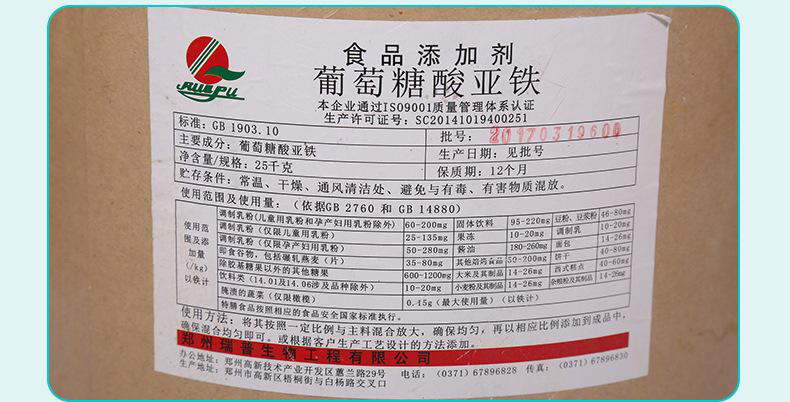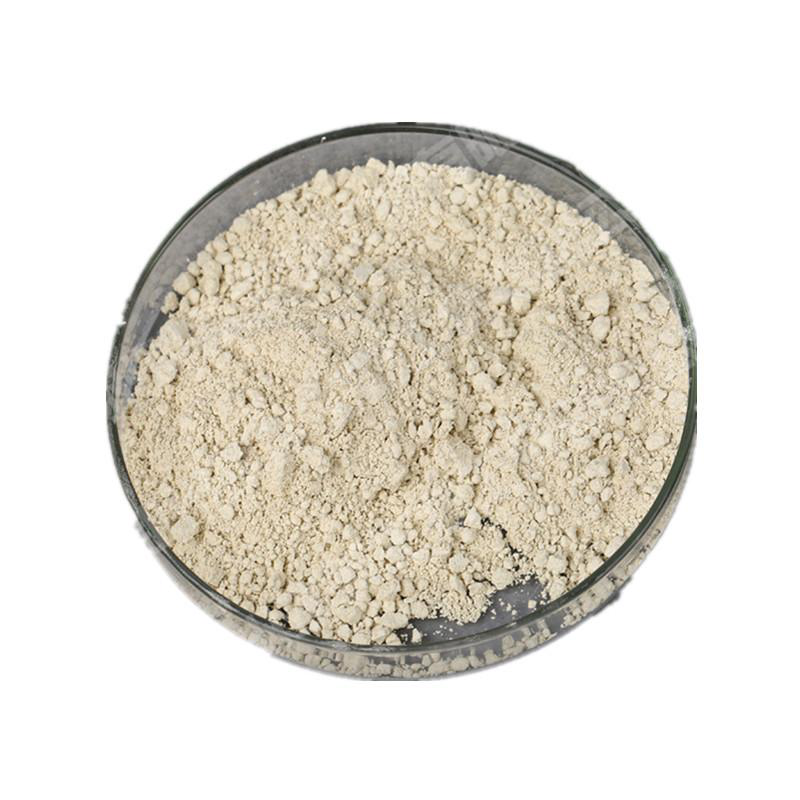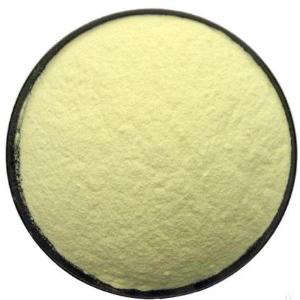Sinoright Blog
Use of ferrous gluconate?
Natur
Ferrous gluconate is yellow-gray or light yellow-green crystal particles or powder with a slight caramel smell. It is soluble in water, 5% aqueous solution is acidic, almost insoluble in ethanol, the theoretical iron content is 12%. Ferrous gluconate is easily absorbed, has no irritation to the digestive system, no side effects, and has no effect on the sensory performance and flavor of food. At the same time, it can be used as a medicine to treat anemia .
Production route
(1) It is made by neutralizing gluconic acid with reduced iron.(2) It is prepared by reacting hot solution of barium or calcium gluconate with ferrous sulfate.
(3) It is obtained by heating and reacting freshly prepared ferrous carbonate and gluconic acid in an aqueous solution .

Identification method
(1) Add 0.65 mL of glacial acetic acid and 1 mL of freshly distilled phenylhydrazine to 5 mL of warm 10% sample solution, heat it on a steam bath for 30 minutes, scrape the inner wall of the container with a glass rod after cooling, and produce phenylhydrazine gluconate crystallization.(2) 5% of this product solution shows a ferrous salt reaction (see the identification method of ferrous sulfate).

Toxicological basis
(1) Oral LD50 rats are 2237mg/kg.(2) GRASFDA-21CFR182.5308.
(3) ADIPMTD10.8mg/kg (tentative maximum allowable monthly intake of iron. JECFA, 2006) .
Application
According to my country's "Health Standards for the Use of Food Nutrition Enhancers" (GB14880-2012), ferrous gluconate can be used as a color protectant for pickled vegetables (only olives), and the maximum use amount is 0.15g/kg. According to Japanese regulations, this product can be used in milk substitutes, weaned foods and milk powder for mothers, etc..Drug description
(In vivo process) The absorption rate of ferrous iron is high. After it enters the blood, it is immediately oxidized to ferric ion, and combined with the transferrin in the plasma to form plasma iron, which is transported to the liver, spleen, bone, etc. with transferrin as a carrier Tissues are stored in the form of ferritin. The iron of ferritin in the bone can be combined into hemoglobin, which becomes myoglobin in skeletal muscle. When iron is lacking, the plasma iron transport rate increases and the absorption rate also accelerates, which increases the amount of iron absorption. This product is mainly excreted through the intestines and skin, and a small amount is excreted through bile and sweat.Drug effect
Same as ferrous sulfate. Participate in the synthesis of hemoglobin, and play an important role in the transmission of oxygen and human metabolic activities.
Adaptation symptoms
It is used for iron deficiency anemia caused by chronic blood loss, menorrhagia, pregnant women, lactating women, and child development.
Adverse reactions and precautions
The iron content is low, so the side effects are lighter. It can cause gastrointestinal discomfort, nausea, upper abdominal pain, diarrhea, constipation, etc.
Medicine analysis
Method name:Determination of ferrous gluconate—neutralization titration method
Scope of application:
This method uses titration to determine the content of ferrous gluconate.
This method is suitable for ferrous gluconate.
Method principle:
After the test product is dissolved in water and 1mol/L sulfuric acid solution, add zinc powder tightly and leave it for 20 minutes until decolorization, filter, wash with freshly boiled cold water, add o-phenanthroline indicator solution, and use The cerium sulfate titration solution (0.1mol/L) is titrated until the solution turns from orange to green. Record the usage of the cerium sulfate titration solution, calculate, and get.
Reagents:
1. Water (newly boiled and put to room temperature)
2. Cerium sulfate titrant (0.1mol/L)
3. O-phenanthroline indicator solution
4. 1mol/L sulfuric acid solution
5. Benchmark arsenic trioxide
Sample preparation:
1. Cerium sulfate titrant (0.1mol/L)
Preparation:Take 42g of cerium sulfate (or 70g of ammonium cerium sulfate), add 500mL of water containing 28mL of sulfuric acid, heat to dissolve, let cool, add appropriate amount of water to make 1000mL, and shake well.
Calibration:
Take about 0.15g of reference arsenic trioxide dried at 105°C to constant weight, accurately weigh it, add 10mL of sodium hydroxide titrant (1mol/L), dissolve with slight heat, add 50mL of water, 25mL of hydrochloric acid, and iodine monoxide test solution 5mL and 2 drops of o-phenanthroline indicator solution. When the titration with this solution is close to the end point, heat to 50°C, continue the titration until the solution turns from light red to light green, and correct the titration result with a blank test. Each 1mL of cerium sulfate titrant (0.1mol/L) is equivalent to 4.946mg of arsenic trioxide. According to the consumption of the liquid and the amount of arsenic trioxide taken, the concentration of the liquid can be calculated.
2. O-phenanthroline indicator solution
Take 0.5 g of ferrous sulfate, add 100 mL of water to dissolve, add 2 drops of sulfuric acid and 0.5 g of o-phenanthroline, shake well, and get it. This solution should be used in a new system.Operation steps:
Precisely weigh 1.5g of this product, place it in an Erlenmeyer flask, add 75mL of water and 15mL of 1mol/L sulfuric acid solution to dissolve, add 0.75g of zinc powder, tightly stopper, and leave it for about 20 minutes until the solution is decolorized. Filter with a No. 4 vertical melting funnel covered with zinc powder to remove the precipitate. The filter is washed with 20 mL of freshly boiled cold water. The washing liquid is combined with the filtrate, and 0.2 mL of o-phenanthroline indicator solution is added, and the cerium sulfate titrant (0.1 mol/L) Titrate until the solution turns from orange to green, and correct the result of the titration with a blank test. Record the volume (mL) of the cerium sulfate titrant consumed, which is equivalent to 1 mL of the cerium sulfate titrant (0.1mol/L) In 44.51mg of ferrous gluconate (C12H22FeO14), it is obtained.
Note 1: "Precision weighing" means that the weighing should be accurate to one thousandth of the weighed weight, and "precision measuring" means that the accuracy of the volume should be in accordance with the national standard for the volume of the pipette. Precision requirements.
Pharmacopoeia content
Added the revised and updated content of the 2010 Chinese PharmacopoeiaFerrous Gluconate
Putaotangsuanyatie
Ferrous Gluconate
Page Number: 2005 Edition Two-692
[Check] Take 0.5g of sucrose and reducing sugar, heat 10ml of water, 1ml of ammonia test solution, shake well, pass hydrogen sulfide to precipitate ferrous ions, let stand for 30 minutes, filter, add 10ml of water to wash twice, combine the filtrate The washing liquid is acidified with dilute hydrochloric acid until the blue litmus paper turns blue, then add 2ml of dilute hydrochloric acid solution, and boil until the steam does not turn the warm lead acetate test paper black, continue boiling to make the solution volume about 10ml, cool, add sodium carbonate 15ml test solution, let stand for 5 minutes, filter, and dilute the filtrate to 100ml with water. Draw 5ml of the solution, add 2ml of alkaline copper tartrate test solution, boil for 1 minute, let stand for 1 minute, no red precipitate will be formed
